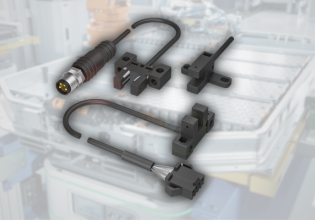Honeywell Develops New Optical Caliper Measurement Sensor for Lithium-Ion Battery Industry
Honeywell released a new optical sensor for determining the thickness of coatings and thin sections.
These optical “calipers” are intended for use in the Lithium-Ion Battery (LIB) industry for accurately measuring the thickness of the electrodes.
The Optical Caliper Measurement Sensor
The Optical Caliper Measurement Sensor can detect variations in coatings as small as 1 micron (0.0393701 thousandths of an inch) in areas as small as 0.5 mm x 0.5 mm (0.019685 inches x 0.019685 in).

The Optical Caliper Measurement Sensor. Image courtesy of Honeywell.
These electrodes must maintain a uniform thickness. Otherwise, there will be a path of “least resistance” where the current will flow more favorably, lowering the entire battery’s efficiency. Also, impurities can change the conductivity of the electrode.
Large defects can cause a battery to fail through an internal short or open circuit based on how the electrode is deformed. Smaller defects can sometimes be corrected with additional processing steps, which can be costly and time-consuming.
Defects are cataloged, and sometimes future processing steps (particularly expensive ones) are withheld from the failed areas.
Lithium-Ion Battery (LIB) Manufacturing
In LIB manufacturing, electrodes undergo a calendaring process, which attempts to make them of uniform thickness. However, this is easier said than done. Anyone who has ever tried to spread cold butter over a cold slice of toast can see all possible problems when making a uniform coating.
If conditions are not perfect, the coating can be applied too thickly in some areas, tear in other areas, and not cover some areas at all. While some of these “defects” are tolerated at breakfast, for LIBs, these defects are unacceptable.

A LIB for an electric vehicle. Image courtesy of Honeywell.
LIB manufacturers attempt to limit the number of defective batteries by performing tests in-house to look for these defects. Therefore, having a method to measure the uniformity of the electrode can help identify defects early.
Before optical methods of thickness measurement, coatings were measured by dragging a very sensitive stylus over the surface. These profilometers could measure the thickness, but the stylus had to physically touch the coating, potentially damaging it.
Additional Features of the LIB Optical Caliper Sensor
Honeywell’s LIB Optical Caliper Sensor provides thickness and uniformity, with the bonus of using a non-contact measurement method.
Instead of laser thickness sensors, which only use one wavelength of light, the LIB Optical Caliper Sensor uses multiple wavelengths in a chromatic confocal arrangement. Laser thickness sensors can be tricked by reflective surfaces, such as the foil used in some LIBs. Lasers can also be fooled by diffuse materials, such as very dark black substances, used in some electrodes. Chromatic confocal sensors are much less susceptible to these problems.
The Honeywell LIB Optical Caliper Sensor integrates with other Honeywell products, such as the ControlEdge Programmable Logic Controllers (PLCs), QCS 4.0 Remote Monitoring Solutions, and others. It additionally includes some third-party OEM found in the LIB industry.
The optical calipers can be configured to work seamlessly with the HMI platform, allowing engineers and technicians to use various advanced and web-based controls.
Outside of the LIB industry, the LIB Optical Caliper Sensor will find uses in any coating-related industry. Solar panel manufacturing, semiconductors, ceramic tape-casting operations, and spray coating industries may benefit from having this type of accurate thickness measurement on hand.





